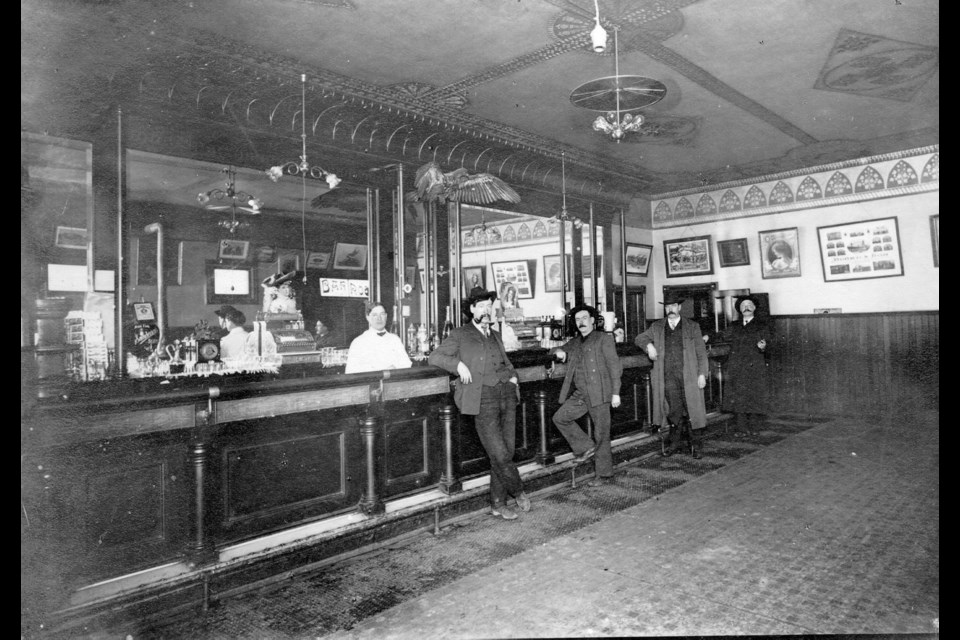From whisky for Fraser gold rush miners to fancy flights of craft beer for today’s hipsters, the Royal City has a long and storied history of drink, and New Westminster Museum and Archives plans to tell the tale during a new exhibit next year.
The idea grew out of the museum’s large collection of vintage bottles, says curator Oana Capota, and out of oral histories the museum collected between 2012 and 2015 for its waterfront exhibit.
“I met with a lot of the longshoremen,” Capota said of the waterfront research, “and something that always came up was that New West was a lot of fun in the ’50s, ’60s and ’70s. There was basically a pub crawl route you could take through New West, and we got interested in that.”
The museum started some preliminary research on the topic of drink about a year ago, looking at 19th-century newspapers.
“Sure enough, there were just dozens and dozens of pubs and saloons,” Capota said.
One of the earliest photos of a drinking establishment researchers found was of The Retreat, a Sapperton saloon established in 1865 (the same year historic Irving House was built).
A newspaper ad a few years later proclaimed the establishment was well known for its good liquors and cigars and was “pleasantly situated within twenty minutes walk of the city” with a good skittle alley (for a type of bowling) and quoiting grounds (for a game like horseshoes but with iron rings).
“It was pretty much the wilderness back then for a lot of people,” Capota said of Sapperton during that time. “People were just starting to build some properties over there.”
But the first watering holes in New West likely predated The Retreat, Capota said, to service miners headed to and from gold fields in the Fraser Canyon during the Fraser gold rush that started in 1857.
“I think they were one of the first businesses to open up,” Capota said.
On a household level, Italian immigrants in Queensborough later imported grape vines, and Russian-Canadians made vodka and a beverage local kids called potato champagne.
As New West grew into a busy shipping terminal, local pubs and bars and saloons serviced a steady stream of sailors and longshoremen, tainting some haunts with less than savoury reputations.
“The Russell Hotel’s name came up,” said Capota about a conversation with a New West resident who came to the city from the prairies as a young woman in the 1960s and spent her first night at the Russell, unaware of its reputation. “She wouldn’t tell me what was shady about it, but I know it was. I’ve heard that place mentioned.”
Capota said the museum hasn’t collected any really bad stories about specific local drinking establishments, but researchers are on the lookout for them.
“A lot of people are kind of shy to put things on record,” she said, “so we’re always looking for anybody who’ll go on record telling us about stuff.”
The museum hopes to find New West residents who have had family stories passed down about forebears who either owned or ran or really just enjoyed patronizing local watering holes.
And researchers don’t intend to shy away from the darker side of alcohol consumption either, or attempts by temperance organizations to stop it (attempts that more or less succeeded during B.C.’s years of prohibition between 1917 and 1921).
The exhibit will also include a look at New West’s drinking culture today, including not just pubs and bars, but coffeehouses, bubble tea shops, and juiceries as well.
SFU sociology and anthropology students started helping the museum with that part of the research last month as part of an advanced class taught by SFU anthropology professor Pamela Stern.
“I am very happy to have this opportunity to work with the New West Museum,” Stern said. “So many of the assignments university students do are artificial, created just for their practice, and that is fine. But when learning how to do social science research, students learn more easily when they to know that someone will be able to make use of the work.”
To hone their ethnographic research skills, the students started conducting interviews with business owners and others who have knowledge about making, selling, and consuming beverages in New Westminster, past and present.
During the summer, students also hope to meet and talk with people who remember some of the city’s former watering holes, people who worked at the former Labatt’s plant, and groups who make and consume their own beverages.
If you have a story to tell or an item to donate that is related to local drinking culture, contact Capota at 604-515-3842 or [email protected].



